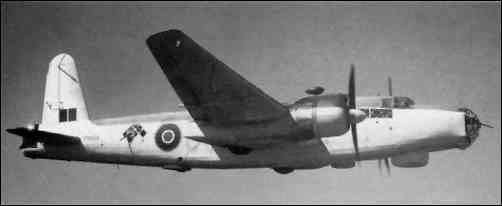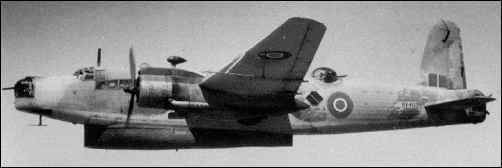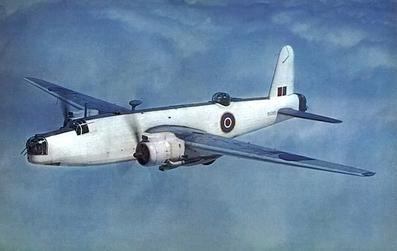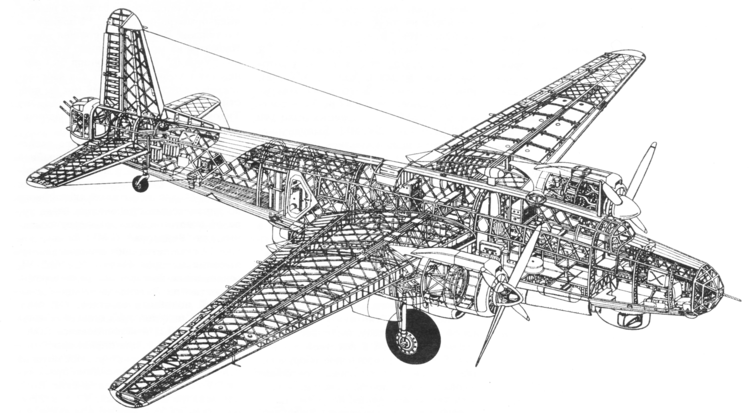Length 22 m Wingspan 29 m First flight August 13, 1939 | Top speed 360 km/h | |
 | ||
Vickers warwick asr1 3d flyaround animation
The Vickers Warwick was a multi-purpose British aircraft used during the Second World War. Designed and manufactured by Vickers-Armstrongs, it was intended to serve as a larger counterpart to their Wellington bomber, sharing similar construction and design principles.
Contents
- Vickers warwick asr1 3d flyaround animation
- Design and development
- Operational history
- Warwick Mark I
- Warwick Mark II
- Warwick Mark III
- Warwick Mark V
- Warwick Mark VI
- Military Operators
- Civil Operators
- Specifications Warwick ASR Mk I
- References

Due to a protracted development, the Warwick was made effectively redundant by rapid aircraft development by rival firms. It was put into operational use by the Royal Air Force (RAF) as a transport, air-sea rescue and maritime reconnaissance platform. The British Overseas Airways Corporation (BOAC) also operated the Warwick in a civil capacity.

As with other RAF heavy bombers of the time it was named after a British city or town, in this case Warwick.

Design and development

The Warwick was designed to meet Air Ministry specification B.1/35 for a two-engined heavy (by the standards of the day) bomber. It was designed in parallel with the smaller Wellington, both being derived from the Vickers Type 271 design to Specification B.9/32.

B.1/35 was drawn up for a twin-engined heavy bomber in January 1935; it was intended to make use of more powerful engines then being developed and thus be both faster and carry a heavier bombload than the B.3/34 specification which would be met by the Armstrong Whitworth Whitley. By the end of July, the Air Ministry was able to consider eight designs. The Vickers 284 with Bristol Hercules engines was placed first and a prototype ordered along with prototypes of the designs by Armstrong Whitworth (AW.39 a developed Whitley) and Handley Page (HP.55). Before the last two had been built they were cancelled - both Handley Page and Armstrong Whitworth preferring to work on the new specifications for medium (P.13/36) and heavy (B.12/36) bombers. Vickers chose to continue but construction was slowed by work on the Wellington, lack of engines and official expectation that the design would be surpassed by later aircraft.

The specification was modified in 1936 for greater fuel and bombload and in 1937 Rolls-Royce Vulture liquid-cooled "X" engines were named as alternative powerplant and adopted in late 1938. In February 1939 it was decided to not proceed beyond the prototypes because of the work required for the Vulture but this was reversed in the following January.
Vickers-Armstrongs completed two prototypes. The first, (serial K8178) powered by the Vultures flew from Brooklands on 13 August 1939. The second prototype (L9704) was originally designed to use Napier Sabre engines, but development of the Sabre was slow, with all production capacity needed for the Hawker Typhoon fighter, so L9704 was instead fitted with the Bristol Centaurus radial engines, flying on 5 April 1940. The Vulture engine, needed for the Avro Manchester, was also unlikely to be available in sufficient numbers for the Warwick, and proved unreliable. While the Centaurus-powered prototype was more promising, the development of the Centaurus was at an early stage and again engines were in short supply. Use of the American Pratt & Whitney Double Wasp radial was proposed. The second prototype was converted to use the R-2800-S14A4-G engines and first flew in this form in July 1941. The Double Wasp installation was inferior to the Centaurus but the aircraft was ordered with the Pratt & Whitney engine.
The Warwick used Barnes Wallis' geodesic airframe construction pioneered in the Wellesley and Wellington. In this system, a network of intersecting structural members made from duralumin were covered by wired-on fabric. The load was distributed amongst the structure, providing great redundancy in the event of damage, at the expense of complexity of construction.
An initial production order for 250 Warwicks, consisting of 150 Double Wasp-powered Mk Is and 100 Centaurus-powered Mk IIs was placed on 28 December 1940. A total of 219 Warwick Mark Is were built, the last 95 with 2,000 horsepower (1,500 kW) R-2800-47 engines.
Operational history
The first production Warwick B Mk I was delivered to the RAF for testing at the Aeroplane and Armament Experimental Establishment, Boscombe Down on 3 July 1942. Only 16 aircraft were delivered as bombers, as by this time more capable four-engined heavy bombers such as the Short Stirling and Handley Page Halifax were in service.
Testing showed the Warwick to be under-powered and with severe handling problems especially flying single engined. The version of Double Wasp fitted to early models proved extremely unreliable with many in-flight failures. Later versions fitted with Bristol Centaurus engines had better performance but the handling problems were never resolved.
The Warwick was subsequently considered for transport and air-sea rescue roles and BV243 was successfully converted into a transport to serve as a trial aircraft, an additional 13 Mk Is were converted on the production line as C Mk I transports for use by BOAC, being used briefly on its Middle East services before being transferred back to RAF Transport Command in 1944. One hundred similar aircraft were built for the RAF as Warwick C Mk IIIs, and entered service with 525 Squadron in June 1944, with three more squadrons operating the Warwick III. They were mainly used in the Mediterranean theatre, as the vulnerability of the fabric skinning to high temperature and humidity stopped plans to operate the Warwick in the Far East, the model remaining in use until retired in 1946.
The remainder of the first batch of 250 Warwicks were used by RAF Coastal Command for anti-submarine reconnaissance. From 1943 Warwicks were loaded with the 1,700 lb (770 kg) Mk IA airborne lifeboat and used for air-sea rescue. The lifeboat, designed by yachtsman Uffa Fox, laden with supplies and powered by two 4 hp (3.0 kW) motors, was aimed with a bombsight near to ditched air crew and dropped by parachute into the sea from an altitude of about 700 ft (210 m). Warwicks were credited with rescuing crews from Halifaxes, Lancasters, Wellingtons and B-17 Flying Fortress, and during Operation Market Garden, from Hamilcar gliders, all of which ditched in the English Channel or North Sea.
A production order for 525 Warwick Mk V was placed although only 235 were ultimately completed, most of which went directly into storage in 1944. In early 1945, the variant was issued to 179 Squadron at RAF St Eval. The Mk V was also used by 17 and 27 Squadrons of the South African Air Force.
Warwick Mark I
Warwick Mark II
Warwick Mark III
Warwick Mark V
Warwick Mark VI
Military Operators
Civil Operators
Specifications (Warwick ASR Mk I)
Data from Vickers Aircraft since 1908.
General characteristics
Performance
Armament
